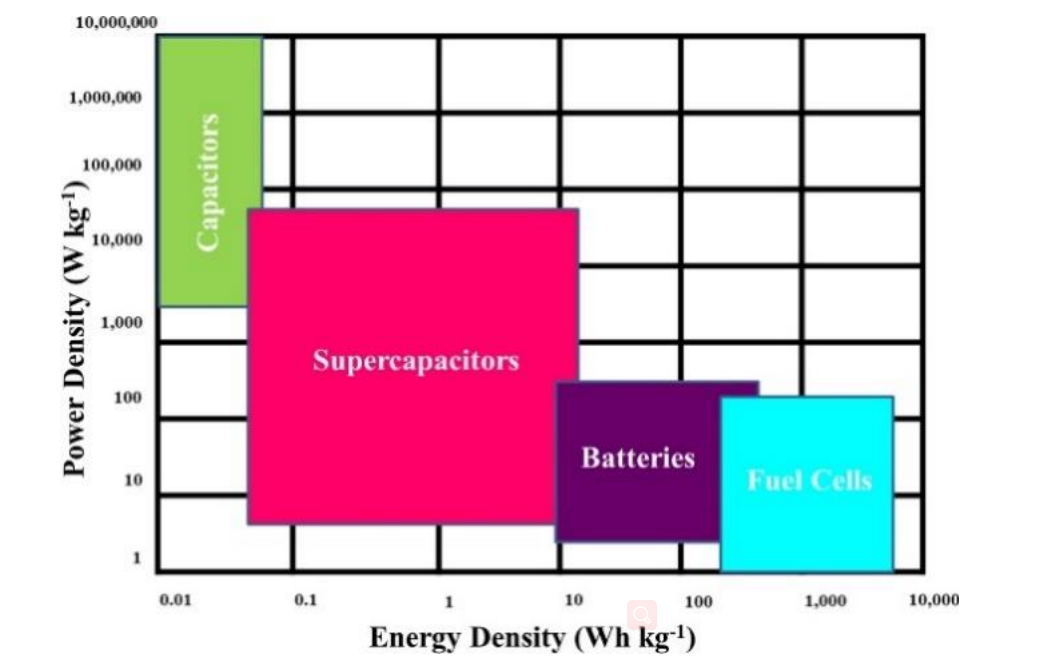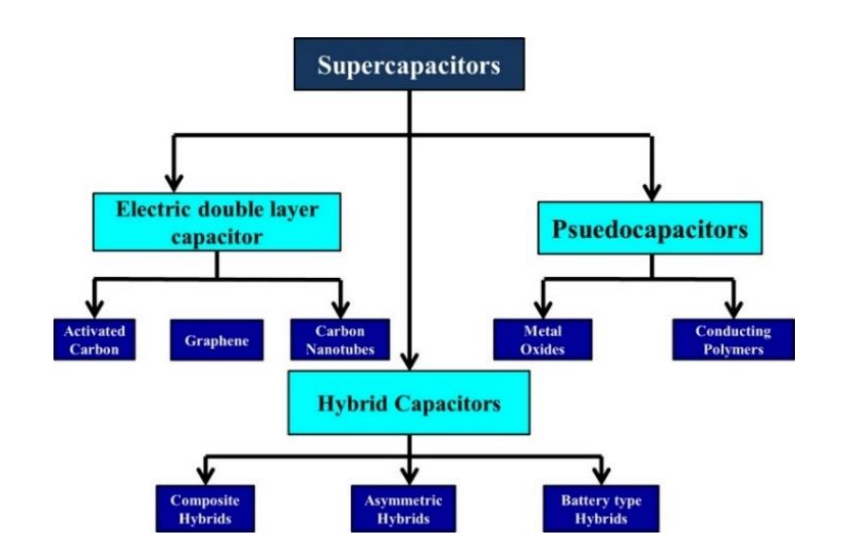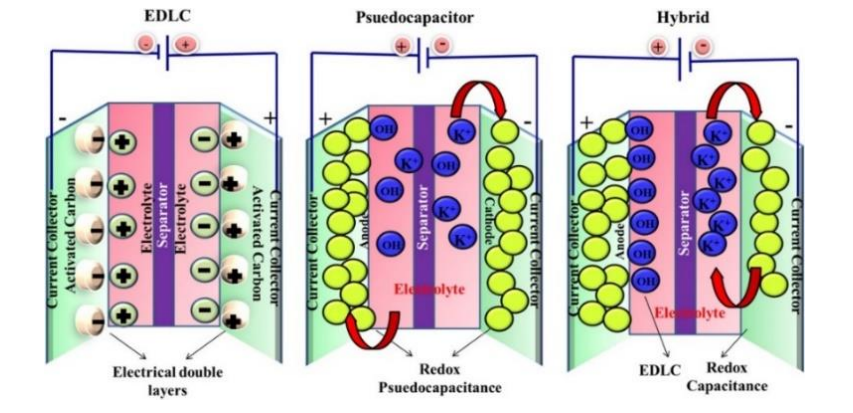A supercapacitor is a high-performance capacitor with many advantages and applications. In this article, we describe how supercapacitors work, their advantages, disadvantages, applications, and safety.
1. Introduction to Supercapacitors
Among various electrochemical energy storage devices, supercapacitors, as an emerging energy storage device, have attracted close attention from society due to their excellent power density. After decades of development and changes, supercapacitors have been widely used in various fields in real life, reflecting important commercial and practical values. As shown in Figure 1-1, compared with batteries, supercapacitors have a longer cycle life and can store and release charges in an instant, making them the focus of the new energy era.

Figure 1-1: Energy density-power density diagram of various energy storage devices
2. Classification of supercapacitors and their energy storage mechanism
A supercapacitor is composed of three parts: electrodes, electrolyte, and diaphragm. Placing the two electrodes face to face can effectively reduce the ion transmission distance and enable the electrode material to give full play to its performance. Separate it with a diaphragm to prevent short circuit caused by direct contact between the positive and negative electrodes, and then soak in the electrolyte. According to whether the electrode materials are the same or not, supercapacitors are divided into two types: symmetrical capacitors and asymmetrical capacitors] (as shown in Figure 1-2).In addition, according to the different energy storage mechanisms, it can also be divided into three types: electric double layer capacitors, pseudocapacitors and hybrid capacitors(as shown in Figure 1-3)

Figure 1-2: Classification of supercapacitors
(1) Electric double layer capacitor
Electric double-layer capacitors mainly rely on the accumulation of charges at the electrode/electrolyte interface for energy storage under the combined action of anions and cations in the electrolyte under the combined action of an external electric field and physical adsorption on the electrode surface. During the charging process, under the action of an external electric field, the negative and positive ions move to both sides of the positive and negative electrodes respectively, and oriented arrangement occurs on the electrode surface to generate a potential difference. During the discharge process, relying on the electrostatic adsorption between anions and cations to make the ions return to the electrolyte, thus completing the entire charge and discharge process.
The energy storage process of the electric double layer capacitor is completed under the influence of the physical force between the charges, that is, the non-Faraday process. Therefore, during the charge and discharge process, the electric double layer electrode material will not undergo volume expansion, irreversible phase transition and other processes, thus showing excellent cycle stability, such as carbon materials. But the disadvantage is that the capacity is low and it is difficult to obtain a higher energy density.
(2) Pseudocapacitive capacitor
Pseudocapacitive capacitors generate higher capacity through the reversible adsorption and desorption process or redox reaction of electrolyte ions on the electrode surface. The main electrode materials are transition metal oxides, hydroxides and sulfides. Compared with electric double layer capacitors, pseudocapacitive capacitors have higher energy density but poorer power density. This is mainly due to the relatively low electronic conductivity of such materials and the relatively slow reaction rate during electrochemical reactions compared with purely physical processes, which cannot match the fast transport process of electrons in external circuits. In addition, the redox reaction is accompanied by the intercalation/extraction of ions, which causes volume expansion and structural transformation of the electrode material, resulting in relatively poor cycle performance. Taking manganese-based oxides as an example, in the neutral electrolyte solution, the intercalation and extraction process of ions causes the electrode material to expand and break, which cannot maintain its original microscopic shape, resulting in capacity fading, and structural transformation. The continuous decrease in material activity leads to poor cycle performance.

Figure 1-3: Energy storage mechanism of different types of supercapacitors
(3) Hybrid capacitors
Hybrid capacitors combine the advantages of pseudocapacitive capacitors and electric double layer capacitors to drive the performance of the entire electrochemical device. According to formula (1-1)
E=1/2CV2 (1-1)
By increasing the voltage window of the entire electronic device, the energy density of the entire device can be effectively improved. Therefore, people take advantage of the different electrode potentials of different materials, and use the pseudocapacitive electrode material and the electric double layer capacitor electrode material as the positive and negative electrodes respectively, so as to expand the voltage window of the entire energy storage device, in order to seek a higher energy density, and make the entire electric Chemical devices are more practical. But the disadvantage is that because the electrochemical reaction rate of the two materials does not match the ion migration rate, the electrochemical performance of the electrode material itself cannot be fully utilized, resulting in low capacity and poor cycle stability.
3. Advantages of supercapacitors
Supercapacitors, also called Ultracapacitors, is a high-performance electrochemical energy storage device. Compared with traditional batteries, supercapacitors have the following obvious advantages:
High power density: The power density of supercapacitors is very high, which can reach several thousand watts per kilogram. This means they can store and release large amounts of energy quickly, making them suitable for instantaneous peak loads or high-frequency charging and discharging applications. For example, braking energy recovery of electric vehicles, emergency power supply of UPS systems, etc.
Long service life: Because supercapacitors store charge between electrode materials rather than through electrochemical reactions, they have a longer service life than traditional chemical batteries. Supercapacitors have a lifetime of hundreds of thousands of charge and discharge cycles, which means they can maintain stable performance over long periods of use.
High efficiency: The energy conversion efficiency of supercapacitors is high, which can reach more than 95%. This means that they can store and release large amounts of energy in a short period of time with reduced energy conversion losses.
Good adaptability to high temperature and low temperature: the performance of the supercapacitor will not be affected by the ambient temperature. Therefore, in an environment of extreme high or low temperature, supercapacitors can still work normally.
Environmentally friendly: supercapacitors do not contain toxic substances such as heavy metals, and will not produce harmful chemical waste during use and will not pollute the environment.
High reliability: Since supercapacitors do not require chemical reactions to store charges, there will be no problems such as battery expansion and internal resistance increase during use. At the same time, the supercapacitor also has overcharge and overdischarge protection functions, which can ensure the safety of use.
Small size and light weight: The structure of supercapacitor is relatively simple, and the material is light and thin, so it is small in size and light in weight. This makes supercapacitors have obvious advantages in occasions where space is limited or light weight is required.
4.Disadvantages of supercapacitors
Compared with ordinary batteries, supercapacitors have many advantages, such as high power density, long life, low internal resistance, fast charging and discharging, etc. However, supercapacitors also have some disadvantages, including the following:
Low energy density: The energy density of supercapacitors is relatively low, usually only a fraction to a few tenths of that of lithium-ion batteries, which means that their energy storage capacity is relatively weak. Therefore, supercapacitors may not be the best choice in some applications, such as those that require energy storage for long periods of time.
Reliability issues: Since the electrode materials of supercapacitors are often required to withstand high voltage and high current, their service life may be affected. Under high-pressure and high-temperature environments, electrode materials may be oxidized, corroded, or damaged, reducing the performance of supercapacitors.
Temperature dependence: The capacitance and internal resistance of supercapacitors tend to be affected by temperature. At extreme temperatures, the performance of supercapacitors may suffer, affecting their reliability and stability in some applications.
High cost: Due to the limitations of electrode materials and structural design of supercapacitors, its manufacturing cost is relatively high. This means that in some applications, supercapacitors may not be the most cost-effective choice.
5. Life and safety of supercapacitors
Supercapacitors have a long service life and high safety, which is one of the reasons for their widespread use in many applications.
In terms of service life, the life of a supercapacitor depends on the quality and structural design of its internal materials. Generally speaking, the service life of supercapacitors can reach tens of thousands to hundreds of thousands of charge and discharge cycles. In contrast, the charge-discharge cycle life of Lithium-ion batteriesis 2000-3000.The advantage of supercapacitor life is that its electrochemical reaction is a physical adsorption/desorption process, which is different from the chemical reaction mechanism of lithium-ion batteries. This physical adsorption/desorption process results in less loss of electrode material and thus a longer lifetime of the supercapacitor.
In terms of safety, supercapacitors are safer than lithium-ion batteries. First, supercapacitors do not produce gas and cannot explode or catch fire. Secondly, the internal electrolyte of supercapacitors generally adopts inorganic salt solution or organic electrolyte, which will not cause chemical reactions or battery leakage, so it has better stability and durability. In addition, the charging and discharging process of a supercapacitor is not affected by temperature, so its charging and discharging performance will not change much under extreme temperatures.
6. Application of supercapacitor
Supercapacitor is widely used in the following fields due to its high power density, long life, high efficiency and other characteristics:
Energy storage and management: supercapacitors can be used as instantaneous storage of energy, and are widely used in occasions that require rapid release of large amounts of energy, such as braking energy recovery of electric vehicles, emergency power supply of UPS (uninterruptible power supply) systems, solar and wind power generation system energy storage, etc.
Electronic equipment: Supercapacitors can be used as a backup power supply or main power supply to provide power for electronic equipment, such as backup power for computer motherboards, driving power for LED lighting, and energy storage for handheld mobile devices.
Transmission and communication: Supercapacitors can release and absorb a large amount of electric energy in a short period of time, so they are widely used in the fields of transmission and communication, such as energy storage systems for electric vehicle charging stations, braking energy storage systems for subways, trains, and trams , UPS backup power supply for telecom base stations, etc.
Aerospace field: Supercapacitors are more and more widely used in the aerospace field, such as the power supply of electronic equipment in aircraft, the power source of electric aircraft, and the energy management of satellites.
Medical devices: Supercapacitors can provide efficient, reliable, and long-life energy storage solutions, and are widely used in medical devices, such as cardiac pacemakers, artificial organs, etc.

We are a professional distributor of electronic components, providing a wide range of electronic products, saving you a lot of time, effort and cost through our meticulous order preparation and fast delivery service.
Share this post


